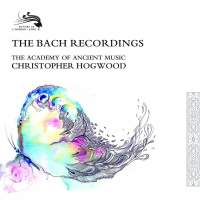Texte paru dans: / Appeared in: |
|
|
Outil de traduction ~ (Très approximatif) |
|
|
Reviewer: James
A. Altena This set is one of several that L’Oiseau Lyre has recently issued of the collected recordings of Christopher Hogwood, being preceded by his pioneering editions of the Mozart and Haydn symphonies. (The latter cycle was never completed, to my infinite regret; if only he’d even just made it through Symphony No. 81 instead of No. 77!) This particular anthology, which gathers together all of Hogwood’s recordings for this label (there are ones on other labels) of music by members of the Bach family (J. S., J. C., C. P. E., and W. F.), originally recorded between 1976 and 1997, is now one in the nature of tribute, as Hogwood died in the course of its preparation. For the most part, it retains the layout of the original releases, with a few odd items that appeared on other discs featuring works by multiple composers being slotted in at appropriate junctures. Despite being a large set, this does not need to be a long review, since every single item here has a detailed review of its previous separate release in the Fanfare Archive. Those notices are all quite rightly uniformly laudatory, and as I have little occasion to quibble with any of them, I see no reason to tire the patience of readers by reinventing the critical wheel. I will therefore limit my comments here to providing basic guidance for those who do not have any or most of these recordings but are considering their acquisition here. Hogwood’s Bach is invariably brisk, even a bit business-like; but even if more recent period instrument versions have learned how to employ more subtle flexibility in phrasing for expressive effect, these pioneering efforts are still unsurpassed for rhythmic vitality and textual clarity. In the set of Brandenburgs, played one performer per part, the first concerto seems a bit stiff and dry, and the second reminds one of those days of yore when even top-notch players of the natural trumpet still had to struggle not to crack and lip notes. After that, however, the remaining four concertos are an absolute joy; the performances of the third and sixth are the finest I’ve ever heard, and the fifth is buoyed by the phenomenal playing of harpsichordist Christophe Rousset, caught in peak form in his youthful prime before the later appearance of some idiosyncratic mannerisms. Rousset likewise elevates the performances of the solo harpsichord concertos to among the finest sets of those available; the multiple harpsichord concertos are good, but do not attain to the same level of effortlessly fluent expressiveness. The various violin concertos, however, once again restore a pinnacle standard of excellence, as all of the soloists play with a sufficient degree of natural vibrato to add a subtle but sweetly burnished warmth to their sound. An arrangement of the Concerto for Three Harpsichords, BWV 1064, for three violins thus makes for a welcome bonus. In the mixed instrument concertos, BWV 1044 for Violin and Flute and BWV 1060R for Violin and Oboe, flutist Rachel Brown excels but oboist Stephen Hammer is merely competent. The set of the four orchestral suites (mostly played with a 5/5/3/2/1 string complement) remains among the finest ever recorded, a true landmark in the Bach discography. I am less satisfied with Hogwood’s ventures as a solo harpsichordist on CDs 8 and 9, in the six French suites, the suites BWV 818a and BWV 819, and the Allemande, BWV 819a; the playing throughout strikes me as technically correct but stiff and inexpressive. To my surprise, my reaction to the two CDs (13 and 14) of cantatas is somewhat mixed. As much as I admire Emma Kirkby, I find her renditions of her parts in the “Coffee” and “Peasant” Cantatas to be a little on the chirpy side and insufficiently varied in expressing the text; tenor Rogers Covey-Crump and bass David Thomas also have nothing distinctive to say, and Hogwood’s conducting likewise seems somewhat detached. Things go much better on the next disc, however, in the three solo cantatas and single cantata movement featuring Kirby alone; here she is by turns radiant and plaintive, and Hogwood is back on form as well. The remaining six discs in the set feature mostly music of three of Bach’s sons, with a couple of odds and ends by J. S. thrown in for good measure. The eight sinfonias of Carl Philip Emmanuel Bach receive superb performances, easily surpassing the quite fine ones by Hartmut Haenchen I reviewed in 37:6 as part of a 30-CD set of the composer’s works that made my Want List for the year. If the six overtures by Johann Christian Bach are definitely of lesser quality, they too benefit from sterling playing and interpretations. Finally, as a keyboard soloist and accompanist, performing variously on clavichord (the C. P. E. Bach Wq 62 sonatas and sonatinas), fortepiano (the C. P. E. Bach flute quartets and the J. C. Bach flute sonatas), and harpsichord (all the rest), Hogwood redeems himself from his uninspired performances of the J. S. Bach keyboard suites and offers renditions that are by turns nimble and heartfelt, and all of his compatriots likewise excel in their variegated star turns.
In sum, the
only way you can go wrong with this set is if you fail to buy it. L’Oiseau
Lyre provides a detailed 52-page booklet with the complete contents of each
disc and an appreciative essay on Hogwood. There is one glaring and annoying
if minor omission: no provision of total track timings for individual discs
(I have added those to the sub-headnotes above). Offered at a bargain price,
this item should be a basic building block of any collection of recordings
of instrumental works by J. S. and C. P. E. Bach; highly recommended. | |
|
|
|
|
Cliquez l'un ou l'autre
bouton pour découvrir bien d'autres critiques de CD |
|




